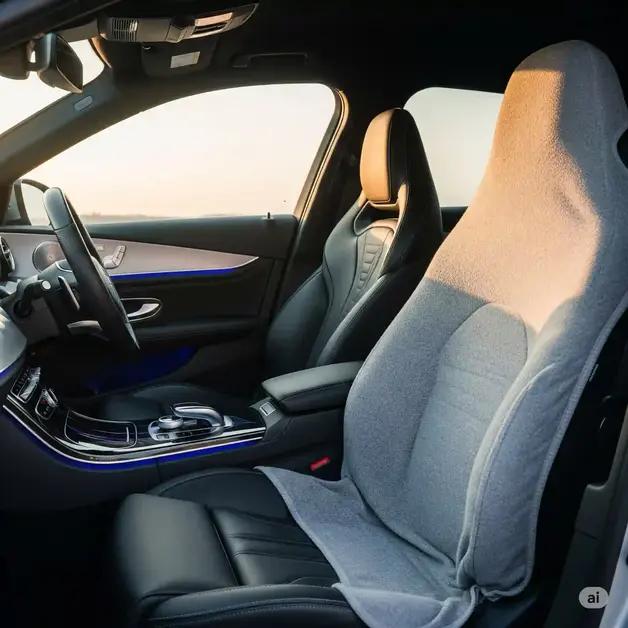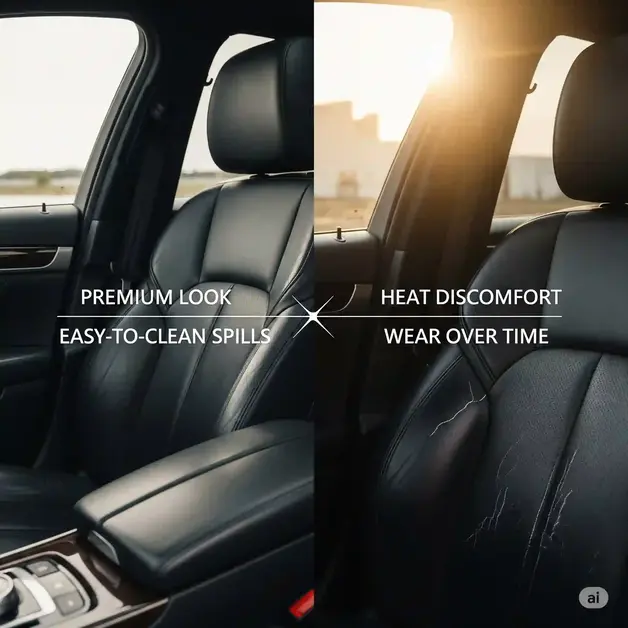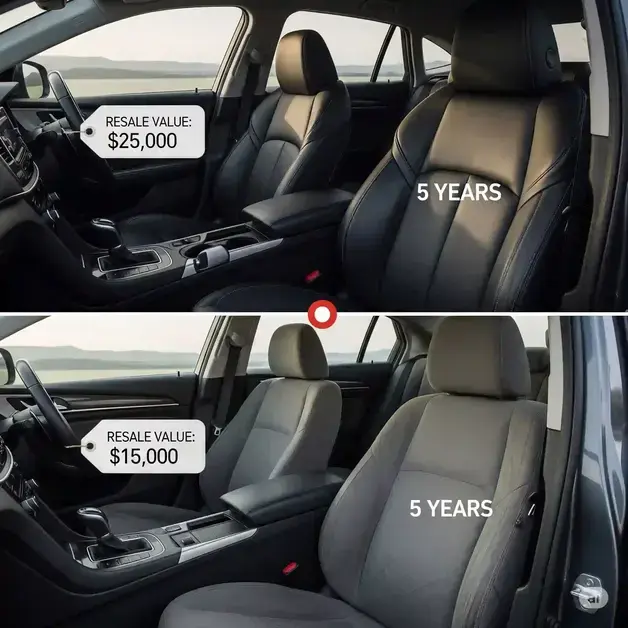When I bought my first car, one of the toughest choices I faced was which seat cover is best for car leather or fabric. At first, I only thought about looks, but soon I realized this decision affects comfort, cleaning, and even resale value. Over the years, I’ve tried both fabric seat covers and leather seats in different cars, and each had its own story to tell. In this guide, I’ll share what I learned about leather vs cloth seats comfort, long-term durability, and how they hold up with kids or even dogs. By the end, you’ll know which option fits your lifestyle best—and maybe even avoid the mistakes I made. Want to find out which cover is truly worth it? Let’s dive in.
Why Seat Covers Matter More Than You Think
When I first bought my car, I thought seat covers were just about looks. Later I realized they do much more. A car seat cover is not only a piece of cloth or leather. It protects your seats, adds comfort, and even affects the resale value of your car. In short, choosing the right seat cover can save you money and stress down the road.
You can start with a good universal fabric seat cover
One big reason seat covers matter is comfort. Imagine driving on a hot summer day—leather can feel like sitting on a frying pan, while fabric stays cooler. On the other hand, leather feels smoother and gives your car a premium vibe. So, if comfort is your top priority, think about your climate and how long you spend in the driver’s seat.
Another factor is budget. Fabric seat covers are cheaper and easier to replace. Leather costs more, but it lasts longer if you care for it. I once spent extra on leather seats and they stayed in good shape for years, while a fabric cover I used in another car wore out in just three. If you’re on a tight budget, fabric makes sense, but for the long run, leather often pays off.
Then comes durability and lifestyle. If you have kids or pets, you know accidents happen—spilled juice, muddy paws, or even crayons on the seat. Leather wipes clean faster, while fabric absorbs stains and smells. However, fabric feels cozier for daily use. For families, this choice often decides how easy life in the car will be.
Your climate is another key point. In cold places, fabric feels warmer, while leather can feel icy until the heater kicks in. In hot areas, leather heats up quickly unless you use sunshades or ventilated seats. That’s why many people choose based on where they live.
So, when someone asks, “Do car seat covers really matter?” the short answer is yes. They impact comfort, cost, and even the future value of your car. The best cover depends on your lifestyle—whether you’re a solo driver, a parent, or a pet owner.
Leather Seat Covers – Pros and Cons
Leather seat covers give your car a premium look, last longer than fabric, and are easy to clean, but they cost more, need regular care, and can feel too hot or cold depending on the weather.
Advantages of Leather Seats in a Car
I still remember the first time I sat in a car with leather seats—it felt like slipping into a nice jacket. Leather instantly gives your car a premium look and makes even an older ride feel more upscale. If you’re someone who loves that “new car” vibe, leather does the trick better than fabric. In short, leather seats make your car look and feel more luxurious.
Another big plus is durability. With proper care, leather can last for years without losing its charm. I had a car with leather seats for nearly eight years, and they still looked good when I sold it. Fabric, on the other hand, usually starts to fade or wear down sooner. So if you’re in it for the long run, leather often outlives fabric.
Leather also helps with resale value. Buyers tend to pay a little extra for a car with leather seats, and I’ve noticed dealerships highlight it as a selling point. It’s one of those upgrades that pays back later. Yes, leather can boost the value of your car when you decide to sell.
And let’s talk about cleaning. Spilled coffee, juice boxes, or dust from the road—leather is much easier to wipe down. I once had a soda spill in my back seat, and with leather it was just a quick wipe. Keeping a leather cleaner and conditioner kit If that same mess had been on fabric, it would’ve been a nightmare. Leather seats are easy to clean compared to fabric.
Disadvantages of Leather Seats in a Car
Of course, leather isn’t perfect. The first summer I owned a car with leather seats, I learned the hard way that they heat up fast. Sitting down on black leather in July felt like sitting on a frying pan. In winter, it’s the opposite—ice cold until the heater kicks in. The biggest downside of leather seats is how they react to hot and cold weather.
They’re also more expensive upfront. When I bought my second car, choosing leather added a noticeable chunk to the price. For many people, that cost makes fabric a more practical choice. Leather seats cost more than fabric, both when buying new and sometimes when replacing covers.
Then there’s the maintenance. To keep leather from drying out or cracking, you have to condition it now and then. I skipped this once, and small cracks started showing on the driver’s seat. Lesson learned. Leather requires regular care to stay in good shape.
Finally, leather scratches. If you have kids or pets, their shoes, toys, or claws can leave marks that don’t fade. My dog once jumped in with muddy paws and left a couple of scratches on the seat that I couldn’t fully fix. Leather seats show scratches more easily than fabric, especially with kids or pets.
Fabric Seat Covers – Pros and Cons
Fabric seat covers are budget-friendly, comfortable in all seasons, and offer more style choices, but they wear out faster, absorb stains, and are harder to keep clean.
Advantages of Fabric Seat Covers
The first car I owned had fabric seats, and honestly, they felt homier than leather. Fabric has a softer touch and doesn’t shock you in extreme weather. On hot days, I never had to worry about burning my legs, and in winter, it stayed warm without waiting for the heater. In short, fabric seats stay more comfortable in all seasons.
Fabric is also much easier on the wallet. Whether you’re buying a new car or just replacing covers, the price is lower than leather. I remember swapping out my old worn covers for new fabric ones at a fraction of what leather would have cost. If you’re on a budget, fabric seat covers are the most affordable option.
Another little detail I came to appreciate was grip. Leather can feel slippery, especially on long drives, while fabric holds you in place. That made a difference for me during road trips, where sliding around wasn’t fun. Fabric seats offer better grip while driving compared to leather.
And let’s not forget variety. There are custom fabric seat covers on Amazon. My cousin once customized his with a funky design, and it completely changed the vibe inside the car. Fabric gives you more choice in design, color, and style than leather.
Disadvantages of Fabric Seat Covers
Now, here’s the tricky part—fabric doesn’t hide mistakes well. I once spilled coffee on my fabric seat, and even after scrubbing, a faint mark and smell lingered for weeks. Unlike leather, it soaks up spills quickly. The biggest drawback of fabric seats is that they stain and absorb odors easily.
Fabric also wears out faster. Over the years, I noticed the driver’s seat fading and getting rough around the edges, while the back seats looked better. That uneven wear makes the car feel older than it is. Fabric seat covers usually don’t last as long as leather, especially with daily use.
Cleaning is another battle. While leather only needs a quick wipe, fabric often requires deep cleaning to get rid of dirt or smells. I had to use a steam cleaner once because regular vacuuming wasn’t enough. Fabric seats are harder to clean and maintain compared to leather.
So while fabric feels cozy and keeps costs low, it demands more care over time. For me, it worked well when I was younger and didn’t mind the upkeep. But as life got busier, I started to value the easy-clean nature of leather. Fabric is great for comfort and budget, but not the best for long-term durability.
Leather vs Cloth Seats – Comfort and Lifestyle Choices
Leather seats feel premium and last longer, while fabric offers better comfort in all seasons. Your lifestyle—kids, pets, climate, and budget—decides which is best.
Leather vs Cloth Seats Comfort
Comfort is usually the first thing people think about when choosing seats. From my experience, leather feels smooth and classy, but it can get tricky with weather. On a hot summer afternoon, my leather seats felt like sitting on a stove, while on winter mornings, they were freezing until the heater warmed up. In short, leather seats look premium but can be less comfortable in extreme climates.
Fabric, on the other hand, is more forgiving. It doesn’t overheat in the sun or feel icy in the cold. I’ve done long road trips in cars with fabric seats, and they felt softer and more breathable over time. If comfort across all seasons matters most, fabric seats usually win.
Leather vs Cloth Seats Long Term
When it comes to the long game, leather has the edge if you take care of it. My old sedan had leather seats that lasted almost ten years with just occasional conditioning. They still looked good when I sold the car, which boosted my resale price. Leather seats are more durable and can improve your car’s resale value.
Fabric doesn’t age as gracefully. After a few years, I noticed wear on the driver’s seat—fading, small tears, and rough patches. Cleaning costs also added up since fabric holds on to dirt and odors. Fabric seats are cheaper upfront, but leather often pays off in the long run.
Leather vs Cloth Seats with Kids
Having kids changes everything. I remember my son spilling juice on our back seat—thankfully, it was leather, and a quick wipe fixed it. With fabric, that same mess would have left a sticky spot and a stain. Leather seats are easier to clean and hold up better against spills and messes.
That said, fabric feels softer and warmer, which kids might find cozier on long drives. But crayons, food crumbs, and muddy shoes can be brutal on cloth. If you have small kids, leather is usually the safer choice for easy cleaning.
Leather or Cloth Seats for Dogs
Pets add their own challenges. My Labrador once jumped in after a rainy walk, and his claws left scratches on the leather. That hurt. Fabric doesn’t scratch as easily, but it does trap fur and smells. I spent countless hours vacuuming dog hair out of fabric seats. Leather resists fur and smells, while fabric is better against scratches.
A good middle ground is using protective covers, no matter what seat type you choose.I started using a waterproof pet seat cover With pets, covers make a big difference—whether you have leather or fabric.
Which Seat Cover is Best for Your Car? (My Recommendation)
When I had to choose between leather and fabric s eats for my own car, I went back and forth for weeks. Leather looked classy and promised durability, while fabric felt cozy and light on the wallet. The truth? There’s no one-size-fits-all answer. The best seat cover depends on your budget, lifestyle, and even the weather where you live.
eats for my own car, I went back and forth for weeks. Leather looked classy and promised durability, while fabric felt cozy and light on the wallet. The truth? There’s no one-size-fits-all answer. The best seat cover depends on your budget, lifestyle, and even the weather where you live.
Who Should Choose Leather Seats
If you want a premium feel and don’t mind spending more, leather is the better choice. It lasts longer, adds to resale value, and is super easy to wipe clean after coffee spills. In hot summers or cold winters, though, leather can feel uncomfortable unless you have seat warmers or cooling. Short answer: choose leather if you want style, durability, and higher resale value.
Who Should Choose Fabric Seats
Fabric seats are for people who value comfort and affordability. They don’t heat up as much in summer, feel softer on long drives, and give you more style options. The downside is they stain and wear faster than leather. Short answer: pick fabric if you’re on a budget, want comfort in all seasons, and don’t mind a bit more cleaning.
The Middle-Ground Option
Not everyone wants to go all-in on leather or fabric. Some cars now come with a blend—fabric with leather trims—or you can add aftermarket covers that mimic leather but cost far less. For example, leatherette seat covers This gives you the best of both worlds: a touch of luxury without stretching your budget. Short answer: choose a mix if you want comfort, style, and affordability in balance.
My personal take, I went with fabric in my first car because I had a tight budget and pets who loved car rides. Later, when I upgraded, I chose leather and haven’t looked back—it’s easier to clean after kids and adds a classy feel. In the end, the best seat cover for your car is the one that makes daily driving easier and more enjoyable for you.
FAQs – Leather vs Fabric Seat Covers
Q1. Which seat cover lasts longer, leather or fabric?
Leather seats usually last longer, often 10 years or more, while fabric seats wear faster with daily use and may need replacing in 5–7 years.
Q2. Are leather seats better for resale value?
Yes, leather seats increase resale value because they look premium, wear well, and appeal to buyers who prefer a luxury interior over fabric.
Q3. Do fabric seats smell worse than leather over time?
Fabric seats absorb spills, smoke, and odors more than leather. Leather is easier to wipe and usually smells fresher with proper cleaning. If odor is a problem, a car upholstery cleaner
Q4. Are leather seats uncomfortable in hot weather?
Leather seats can feel hot in summer and cold in winter. Seat covers, tints, or cooled/heated seat features make them more comfortable year-round.
Q5. What’s the best seat cover for kids and pets?
Leather is easier to clean messes from kids and pets, but fabric is softer. Using protective covers gives the best balance of comfort and durability. I recommend a washable car seat protector
Final Words
If you love a premium feel and don’t mind extra upkeep, leather seats are a solid choice. But if comfort, budget, and easy living matter more, fabric can be just as rewarding. Personally, I’ve found each has its place—so choose the one that fits your lifestyle best, not just what looks good in the showroom.

